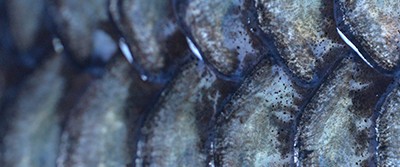Fish Slime Swimming with Pathogen-Killing Bacteria

By Christina Phillis
Most fish are equipped with a slimy protective coating that helps them escape from potential predators, but also guards them from various germs. Scientists at Oregon State University in Corvallis are searching this fish slime for bacteria that can be used to create new antibiotics.
Novel drug options are needed because many pathogens are no longer responding to existing medicines. One significant example is a methicillin-resistant strain of Staphylococcus aureus (known as MRSA).
These bacteria used to be completely susceptible to penicillin and related antibiotics. But after adapting over years of exposure, S. aureus bacteria have become completely resistant to those antibiotics. As a result, MRSA infections are notoriously difficult to treat, and typically require intravenous therapy with multiple medications.
While researchers had not previously considered fish slime when searching the ocean for new drug sources, it may prove to be a promising area of study. “We know that niche environments often harbor a surprising array of different microorganisms,” said Roger Linington, chemist, Simon Fraser University in Vancouver, Canada.
Slime Attack
After collecting swabs of slime from 17 species of juvenile fish, the team of researchers smeared the swabs on petri dishes filled with agar and other nutrients for the bacteria. As expected, the bacteria grew in different sizes and shapes, some as blue-green streaks, and others as orange splotches. They used these and other features to classify the bacteria and found a total of 47 different types.
About half were effective against MRSA, and five of the strains, collected from a pink surfperch, were very effective at killing MRSA.
Something Fishy
The bacteria from surfperch produce molecules called phenazines, which allow it to kill other bacteria. This makes phenazines a potential candidate for new and useful drugs for humans and a strain the team is eager to learn more about.
By studying 10 new specimens of this fish variety, they hope to find out how important this strain of bacteria is for the slime ecosystem of the surfperch. If the bacteria are present, they will test them to see if they also produce phenazines.
Sandra Loesgen, a chemist at Oregon State University and researcher on the team, believes there is still a lot to understand about how microbes affect the health of their hosts. “We need to have much more effort in that area to isolate the bacteria and understand their function,” said Loesgen.
Over time, the team hopes to find more than just well-known bacteria and molecules. They want to find new and useful solutions that stick.
Discussion Questions
- Research the issues associated with antibiotic resistance. Why is this such an important problem to overcome?
- Where can researchers find other naturally occurring bacteria to study for potential drug development?
Vocabulary
- Antibiotic Resistance
- Microbes
- Phenazines
- Pathogens